|
|
|
|
|
|
Main signals control the movement of trains along running lines. To enable safe running at speed, they are designed to present drivers with unambiguous indications that can be clearly viewed and interpreted from a long distance on the approach side. In exceptional situations where restricted clearances prevented the installation of an ordinary main signal, it was sometimes necessary to install a signal in the form of a shunting signal (see Section 4) that functioned as a main signal.
The first railway semaphore signal was erected in 1841 at New Cross Gate by Charles H Gregory, Engineer of the London & Croydon Railway. During daylight hours, a semaphore signal conveys its indications by a pivoted 'arm'. The arm projects to the left of the post when viewed in the applicable direction of travel, and its angle determines the indication. The first semaphores were three-position signals, used in conjunction with the time interval system. The 'danger' indication was given by the arm being in the horizontal position [2.1]. When in this position, a red light was shown at night. For the 'caution' indication, the arm was lowered through 45°, and a green light was displayed at night [2.2]. In the 'clear' position, the arm dropped down vertically to be hidden inside a slot in the post, and a white light was shown at night [2.3]. By the 1860s, semaphore signals were in widespread use, apart from on the Great Western Railway and the London & South Western Railway. The GWR began installing semaphores in 1865.
 |
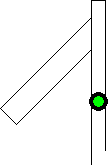 |
 |
|
[2.1] Semaphore Signal showing 'Danger'.
Area: Various Usage: High Status: Historical |
[2.2] Semaphore Signal showing 'Caution'.
Area: Various Usage: High Status: Historical |
[2.3] Semaphore Signal showing 'Clear'.
Area: Various Usage: High Status: Historical |
|---|
With the gradual introduction of the Absolute Block system, semaphore signals were only required to show two indications, 'danger' (see [2.1]) or 'clear' (see [2.3]); however, at busy junctions etc. where more caution was required, signals continued to show either 'danger' (see [2.1]) or 'caution' (see [2.2]). The Great Western Railway was the first company to abolish the 'caution' indication, in June 1873.
|
Gradually, semaphore signals came to be worked to 45° for the 'clear' indication [2.4], rather than the former indication in which the arm had been hidden inside the post (see [2.3]). |
|
Initially, semaphore arms coloured all-red were used by the GWR, the London & North Western Railway and the Metropolitan Railway [2.5 & 2.6].
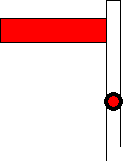 |
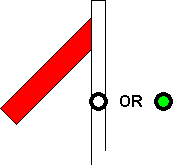 |
|
[2.5] Semaphore Signal ('on').
Area: GWR / LNWR / Met.R Usage: High Status: Historical |
[2.6] Semaphore Signal ('off').
Area: GWR / LNWR / Met.R Usage: High Status: Historical |
|---|
Before long, a marking in a contrasting colour was being added to signal arms to make them more conspicuous to drivers. The London, Brighton & South Coast Railway's signal arms were originally coloured white with a red stripe (black stripe on the rear) [2.7 & 2.8].
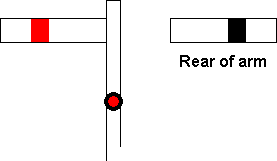 |
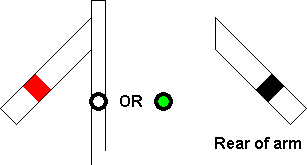 |
|
[2.7] Semaphore Signal ('on').
Area: LB&SCR Usage: High Status: Historical |
[2.8] Semaphore Signal ('off').
Area: LB&SCR Usage: High Status: Historical |
|---|
Most other railways used red arms with a white stripe [2.9 & 2.10], which later became the accepted standard.
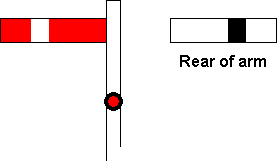 |
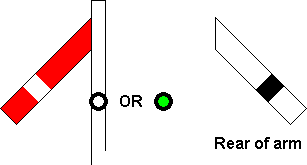 |
|
[2.9] Semaphore Signal ('on').
Area: All Areas Usage: High Status: Current |
[2.10] Semaphore Signal ('off').
Area: All Areas Usage: High Status: Historical |
|---|
Semaphore signals on the South Eastern Railway had a white spot on the front of the arm instead of a stripe [2.11 & 2.12].
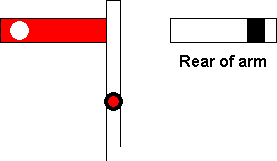 |
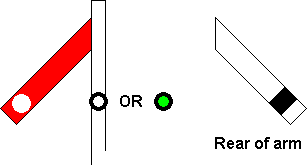 |
|
[2.11] Semaphore Signal ('on').
Area: SER Usage: High Status: Historical |
[2.12] Semaphore Signal ('off').
Area: SER Usage: High Status: Historical |
|---|
Midland Railway and Cambrian Railways semaphores had spots on both sides of the arm [2.13 & 2.14].
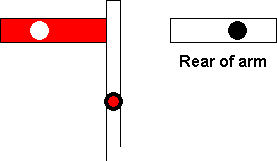 |
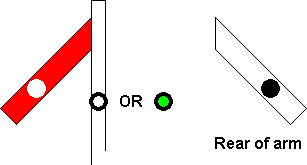 |
|
[2.13] Semaphore Signal ('on').
Area: Mid.R / Cam.R Usage: High Status: Historical |
[2.14] Semaphore Signal ('off').
Area: Mid.R / Cam.R Usage: High Status: Historical |
|---|
The London & North Western Railway had opened a third line for goods traffic as far as Bletchley, in stages from 1858. Semaphore signals had been installed on the new third line to avoid confusion with the existing signals on the passenger lines, which were of the old disc type (see [1.54 & 1.55]). To ensure that the goods line signals could be distinguished by drivers during darkness, a second lamp, which permanently showed a green light, was placed below the usual signal lamp. Thus, a driver running at night would see a red light over a green light for the 'danger' indication [2.15], and a white light over green for 'clear' [2.16].
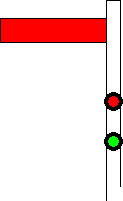 |
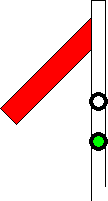 |
|
[2.15] Semaphore Signal with additional Green Light ('on').
Area: LNWR Usage: High Status: Historical |
[2.16] Semaphore Signal with additional Green Light ('off').
Area: LNWR Usage: High Status: Historical |
|---|
By 1867, semaphore signals had been installed on the passenger lines referred to above. Rings were fitted to the arms of the goods line signals [2.17 & 2.18] so that they would remain distinguishable from the passenger line signals during daylight. The LNWR was the first company to use ringed signal arms. It continued to fit rings to assist drivers in distinguishing signals where they were placed side by side on multiple track sections. Generally, the signal arms applying to goods lines or slow lines were fitted with rings, or where there were many lines, signals applying to alternate lines were fitted.
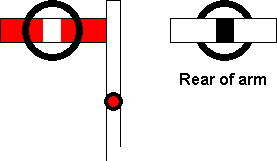 |
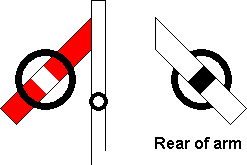 |
|
[2.17] Ringed Semaphore Signal ('on').
Area: Various Usage: High Status: Historical |
[2.18] Ringed Semaphore Signal ('off').
Area: Various Usage: High Status: Historical |
|---|
|
|